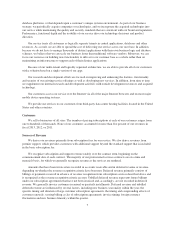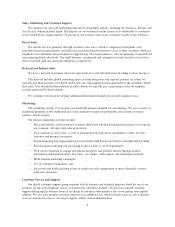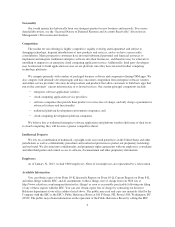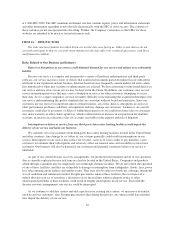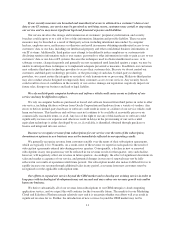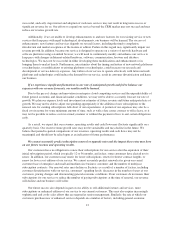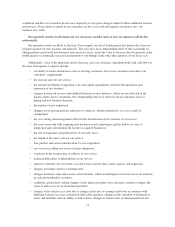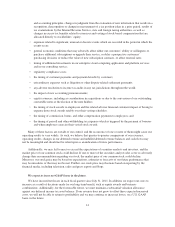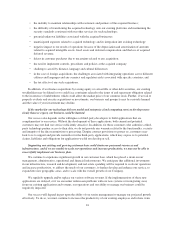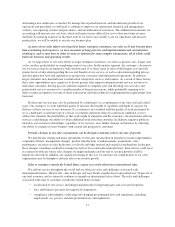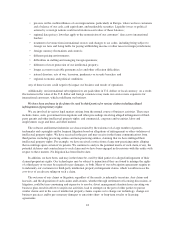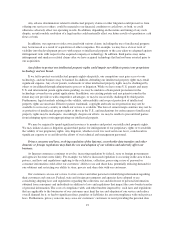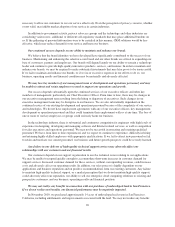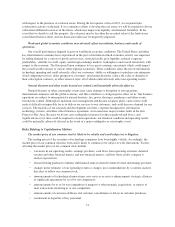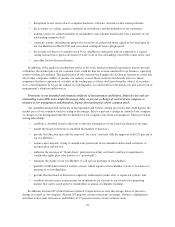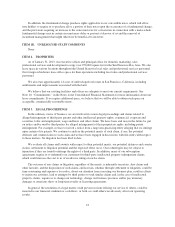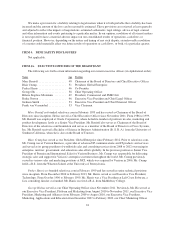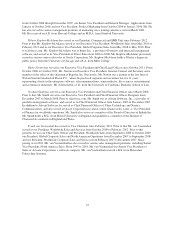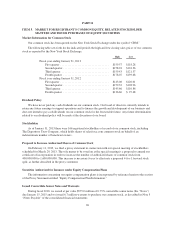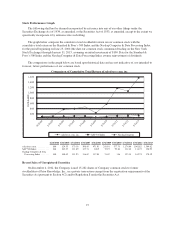Salesforce.com 2013 Annual Report Download - page 21
Download and view the complete annual report
Please find page 21 of the 2013 Salesforce.com annual report below. You can navigate through the pages in the report by either clicking on the pages listed below, or by using the keyword search tool below to find specific information within the annual report.and manage new employees as needed. To manage the expected domestic and international growth of our
operations and personnel, we will need to continue to improve our operational, financial and management
controls, our reporting systems and procedures, and our utilization of real estate. The additional investments we
are making will increase our cost base, which will make it more difficult for us to offset any future revenue
shortfalls by reducing expenses in the short term. If we fail to successfully scale our operations and increase
productivity, we will be unable to execute our business plan.
As more of our sales efforts are targeted at larger enterprise customers, our sales cycle may become more
time-consuming and expensive, we may encounter pricing pressure and implementation and customization
challenges, and we may have to delay revenue recognition for some complex transactions, all of which could
harm our business and operating results.
As we target more of our sales efforts at larger enterprise customers, we will face greater costs, longer sales
cycles and less predictability in completing some of our sales. In this market segment, the customer’s decision to
use our service may be an enterprise-wide decision and, if so, these types of sales would require us to provide
greater levels of education regarding the use and benefits of our service, as well as education regarding privacy
and data protection laws and regulations to prospective customers with international operations. In addition,
larger customers may demand more customization, integration services and features. As a result of these factors,
these sales opportunities may require us to devote greater sales support and professional services resources to
individual customers, driving up costs and time required to complete sales and diverting our own sales and
professional services resources to a smaller number of larger transactions, while potentially requiring us to
delay revenue recognition on some of these transactions until the technical or implementation requirements have
been met.
Professional services may also be performed by a third party or a combination of our own staff and a third
party. Our strategy is to work with third parties to increase the breadth of capability and depth of capacity for
delivery of these services to our customers. If a customer is not satisfied with the quality of work performed by
us or a third party or with the type of services or solutions delivered, then we could incur additional costs to
address the situation, the profitability of that work might be impaired, and the customer’s dissatisfaction with our
services could damage our ability to obtain additional work from that customer. In addition, negative publicity
related to our customer relationships, regardless of its accuracy, may further damage our business by affecting
our ability to compete for new business with current and prospective customers.
Periodic changes to our sales organization can be disruptive and may reduce our rate of growth.
We periodically change and make adjustments to our sales organization in response to market opportunities,
competitive threats, management changes, product introductions or enhancements, acquisitions, sales
performance, increases in sales headcount, cost levels and other internal and external considerations. In the past,
these changes sometimes resulted in a temporary lack of focus and reduced productivity; these effects could recur
in connection with any future sales changes we might undertake and our rate of revenue growth could be
negatively affected. In addition, any significant change to the way we structure our compensation of our sales
organization may be disruptive and may affect our revenue growth.
Sales to customers outside the United States expose us to risks inherent in international sales.
We sell our service throughout the world and are subject to risks and challenges associated with
international business. Historically, sales in Europe and Asia Pacific together have represented over 30 percent of
our total revenues, and we intend to continue to expand our international sales efforts. The risks and challenges
associated with sales to customers outside the United States include:
• localization of our service, including translation into foreign languages and associated expenses;
• laws and business practices favoring local competitors;
• compliance with multiple, conflicting and changing governmental laws and regulations, including
employment, tax, privacy and data protection laws and regulations;
17


